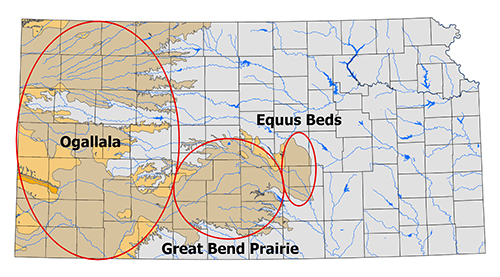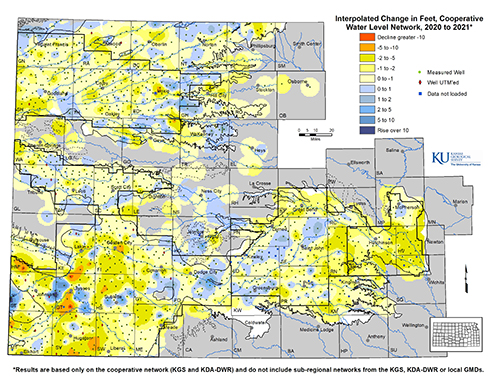High Plains Aquifer Groundwater Levels Continue to Decline
News Release, Kansas Geological Survey, February 22, 2021
Groundwater levels fall in central and western Kansas
LAWRENCE — After three years of small increases, average groundwater levels in central and western Kansas dropped during 2020 as most of the area experienced abnormally dry conditions for much of the year, according to preliminary data compiled by the Kansas Geological Survey.
"It was hot and dry last summer, and water levels pretty much dropped everywhere," said Brownie Wilson, KGS water-data manager. "Levels didn't drop as much as in the really dry years of 2011 and 2012, but declines were a step in that direction."
Water levels in measured wells declined an average of 0.93 feet overall in 2020. In the drought years of 2011 and 2012, average levels across all monitored wells decreased 1.95 and 2.04 feet, respectively. About 90% of the monitored wells are drilled into the High Plains aquifer.
The KGS, based at the University of Kansas, and the Division of Water Resources (DWR) of the Kansas Department of Agriculture measure about 1,400 wells every year to monitor the health of the High Plains aquifer and other aquifers in western and central Kansas. Since 1996, when the state began administrating the water-level program, water levels in the monitored wells have declined on average 12 feet.
The High Plains aquifer is a network of water-bearing rock that extends into eight states. In Kansas, the aquifer comprises three components - the Ogallala aquifer, the Great Bend Prairie aquifer, and the Equus Beds. Of these, the Ogallala aquifer underlies most of western Kansas and consists mainly of the Ogallala Formation, a geologic unit that formed from sediment eroded off the uplifting Rocky Mountains.
Dry years lead to increased pumping demands, primarily for irrigation, which in turn typically cause greater declines in water levels. In 2020, much of western Kansas saw only 50 to 75 percent of normal precipitation. During the growing season of March to September, most of the region received less than 25 percent of normal precipitation.
"The irrigation season probably started earlier than normal, and for some areas producers couldn't afford to stop to just maintain adequate soil moisture levels. When you start off that far behind, it can be rough to catch back up," Wilson said.
The southwest Kansas portion of the Ogallala has suffered the greatest losses since levels started dropping in the 1950s. In the drought years between 2010 and 2014, declines averaged about three feet per year. Since 2015, levels fell less than a foot each year until 2020, which saw a decline of 1.2 feet.
In central Kansas, the Great Bend Prairie aquifer underlies an area encompassing Great Bend, Kinsley, Greensburg, and Pratt. Farther east, the Equus Beds extends from just north of Wichita toward McPherson and Hutchinson.

This area typically sees more precipitation than the western part of the state. Because the aquifer is relatively close to the land surface and sandy soils are abundant, some of this precipitation recharges - or makes its way into - the aquifer. Since 1996, water levels in this area have remained relatively stable.
Most of the wells in the network monitored by the KGS and DWR are within the boundaries of the state's five Groundwater Management Districts (GMDs), which are organized and governed by area landowners and local water users to address water-resource issues.
In Southwest Kansas GMD 3, average groundwater levels dropped 1.31 feet in 2020. Since 1996, average levels in GMD 3 have declined more than 35 feet. Most of the wells monitored in GMD 3 are drilled into the Ogallala aquifer except in a few areas where they draw from the deeper Dakota aquifer. GMD 3 includes all or part of Grant, Haskell, Gray, Finney, Stanton, Ford, Morton, Stevens, Seward, Hamilton, Kearny, and Meade counties.
Western Kansas GMD 1 experienced a drop of 0.59 feet in 2020. Declines there tend to be small but steady, with a total recorded loss of nearly 11 feet since 1996. The only decline over a foot recorded during that time was a 1.46-foot drop in 2002, but only three years had gains — all less than half a foot. GMD 1 includes portions of Wallace, Greeley, Wichita, Scott, and Lane counties, where the majority of wells are drilled into the Ogallala aquifer.
Northwest Kansas GMD 4 experienced a drop of 0.75 feet, after three years of small increases. Since 1996, average levels have dropped more than 11 feet. GMD 4 covers Sherman, Thomas, Sheridan, and parts of Cheyenne, Rawlins, Decatur, Graham, Wallace, Logan, and Gove counties. Groundwater there is pumped from the Ogallala aquifer and shallow alluvial sources associated with streams.

In contrast to the significant declines observed in the western Kansas GMDs, increases and decreases in water levels in Great Bend GMD 5 and Equus Beds GMD 2 in the central part of the state tend to even out over time. Although both districts have localized areas of long-term groundwater declines, GMDs 2 and 5 as a whole have remained relatively stable.
Big Bend GMD 5, centered on the Great Bend Prairie aquifer, experienced a water-level decline of 0.81 feet in 2020 after increases of 1.76 feet in 2019 and 1.22 feet in 2018. The Great Bend Prairie aquifer underlies Stafford and Pratt counties and parts of Barton, Pawnee, Edwards, Kiowa, Reno, and Rice counties.
Equus Beds GMD 2, a major source of water for Wichita, Hutchinson, and surrounding towns, saw the biggest decline of all the GMDs in 2020, a decrease of 1.80 feet, after increases of 1.38 feet in 2018 and 0.82 feet in 2019. GMD 2 covers portions of Reno, Sedgwick, Harvey, and McPherson counties.
"GMD 2 often fluctuates with periods of large declines and large increases in the water table. Like other areas of Kansas, irrigation is a major use made of water but GMD 2 also has much larger municipal and industrial applications relative to the other GMDs," Wilson said.
The KGS measured 587 wells in western Kansas, and DWR staff from field offices in Stockton, Garden City, and Stafford measured 224, 276, and 341 wells, respectively, in western and central Kansas. Most of the wells, spread over 48 counties, are used for irrigation and have been measured for decades with landowners' permission.
Measurements are taken primarily in January when water levels are least likely to fluctuate due to seasonal irrigation. The measurement results, available on the KGS Water Well Levels web page, are provisional and subject to revision based on additional analysis.
The Kansas Geological Survey is a non-regulatory research and service division of the University of Kansas. KGS researchers study and provide information about the state's geologic resources and hazards, including groundwater, oil and natural gas, rocks and minerals, and earthquakes.
Contact: Brownie Wilson, 785-864-2118, bwilson1@ku.edu.
Kansas Geological Survey, Public OutreachURL="http://www.kgs.ku.edu/General/News/2021/groundwater_levels_fall.html"
Source: https://www.kgs.ku.edu/General/News/2021/groundwater_levels_fall.html
0 Response to "High Plains Aquifer Groundwater Levels Continue to Decline"
Post a Comment